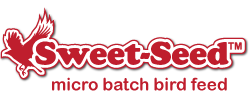Bagged Seed or Seed Cakes – Which Is Best?

Birdseed comes in two forms – loose seed that is added to feeders, and molded seed that is pressed into cakes or other shapes. What are the differences between them, and which is best to offer your backyard birds? Understanding the pros and cons of each type can help you choose which will meet your birds' needs best.
Loose/Bagged Birdseed
Bags of birdseed are common in many stores and garden centers. Seeds may be available as single-seed bags, such as five pounds of sunflower hearts, or they come in a variety of seed blends with several seeds mixed in different proportions to appeal to specific types of birds, such as a finch mix or songbird blend. Because the seed is loose in the bags, it can be added to any type of seed feeder, and larger bags can be purchased for bulk savings. It is easy to control how much seed is offered to backyard birds at once, or to adjust which seeds are offered as birds' dietary needs change, new birds visit the yard or other species depart on migration.
Loose birdseed isn't always great, however. It may spill easily if feeders are tipped or birds toss out less popular seeds to reach their favorite morsels. If a too-large bag is purchased, seed can start to mold before it is added to feeders, or a bag of seed could become infested with bugs or be breached by industrious rodents. When oil-rich seed is added to feeders, it can stain wood, and hulls, dust and other debris make feeders dirty more quickly.
Seed Cakes
Seed cakes are generally made from the same types of birdseed found in loose bags, but the seed has been combined with a sticking agent (such as gelatin) and pressed into a firm shape. This shape holds even as the seed is gradually eaten away by birds. Seed cakes come in a standard square shape, as well as many quirky seasonal shapes such as bells, hearts, snowmen, pumpkins, stockings, wreaths and more. Cakes are durable and often last longer than the same quantity of birdseed, since birds have to work just a little harder to extract each bite. Some cakes come with strings or ribbons attached and can be hung without the aid of extra feeders, while others can be put into standard suet cages or added to platform feeders.
If birds don't nibble away at the cake quickly enough, however, it could become waterlogged and rot or fall apart. Seed cakes are often more expensive than similar quantities of loose seed, but generally use higher quality seeds with less filler. If cakes are placed in platform feeders or larger cakes are on the ground, they may attract far more wildlife than just birds, including squirrels, rats, raccoons and other visitors who may not be wanted in the backyard.
Choosing How to Feed Your Birds
So which is best for your birds? It's a personal choice every backyard birder has to make, and a combination of loose seed and seed cakes is often the way to go. Loose seed can be more personalized, but cakes are ideal for times when it may not be possible to refill feeders as frequently, such as when you are away on vacation. Cakes can also be great options for winter, when they aren't as prone to softening and clinging birds such as nuthatches, creepers and small woodpeckers are visiting the yard more frequently and will cling right to the cake.
Ultimately, both loose birdseed and seed cakes have pros and cons for every backyard. Understanding which works best for your birds will help you choose just the right feeding options that maximize the nutritious treats you offer birds while minimizing any spilling, cleanup or wasted seed.
